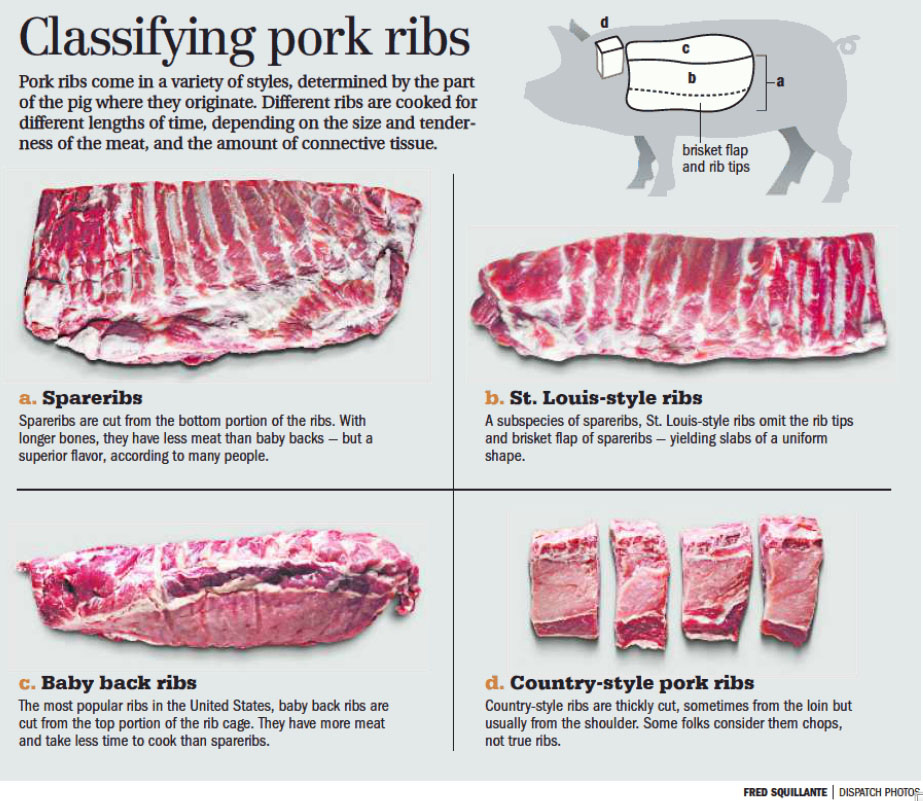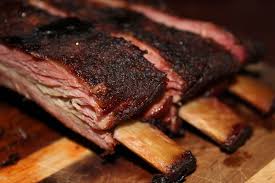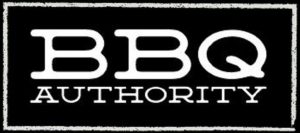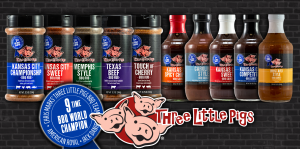Tutorial on Pork Ribs Cuts
Baby Back Ribs: The most popular of all pork ribs, Baby Backs are the most lean and tender. These types of ribs are located at the top part of the rib bone that is connected to the spine (backbone), just below the loin muscle. The name “Baby” is derived from the fact they are shorter than spare ribs, and “Back”, because they are nearest the backbone.
Butchers make Baby Back Ribs by cutting them where the longest bone is, around 6″ from the spine. The meat on top of the bones is tender and delicious. Depending on how they are butchered, Baby Back Rib racks weigh about 1.75-2.5 lbs and will normally have between 10-13 bones per rack. Baby Backs can be grilled, barbecued, roasted and smoked. They are typical to the northern region of the U.S. and Canada.
Spare Ribs: Rib starts from the end of Baby Back Ribs and extends to the end of the rib bone. Spare Ribs are bigger with more meat between the bones than the top of the bones
and are a little tougher and fatter, but much richer in flavor. Spare Ribs average 10-13 bones per rack weighing between 2.5 – 3.5 lbs. They can also be grilled, barbecued, roasted and smoked.
St. Louis Ribs in the St. Louis area who wanted a better rib cut than they were receiving from big meat packers at the time. St. Louis Ribs, or St. Louis Style Ribs are Spare Ribs with the rib tips cut off where a lot of cartilage and gristle exists with very little meat.  “Pork Ribs, St. Louis Style” officially became an official USDA cut standard NAMP/IMPS #416A in the 1980’s. Spare Ribs and St. Louis Style Spare Ribs are found on grills and smokers in the southern states of the U.S.
“Pork Ribs, St. Louis Style” officially became an official USDA cut standard NAMP/IMPS #416A in the 1980’s. Spare Ribs and St. Louis Style Spare Ribs are found on grills and smokers in the southern states of the U.S.
Rib Tips Rib Tips are found at the end tips of the rib bone. They are the by-products of St. Louis Ribs where butchers cut the tips off the end of the ribs into strips with a saw.  Even with little meat and a lot of cartilage and gristle, Tips are rich in flavor due to the presence of bone and higher fat content. People generally either love them or hate them.
Even with little meat and a lot of cartilage and gristle, Tips are rich in flavor due to the presence of bone and higher fat content. People generally either love them or hate them.
Country-Style Ribs You may be surprised to know that Country-style Ribs are not cut from the rib cage but from the front end of where the Baby Back Ribs are near the shoulder blade. They are the meatiest variety of ribs and are perfect for those who prefer to use a knife and fork rather than eating with their hands.
Rib Chops & Roasts: Bones are also used in other types of butcher cuts. Rib Chops are  produced where the loin meat is kept attached to the bone and portion cut into a chop. The end of the rib bone can also be exposed to create a “French Cut” Rib Chop. A Crown Roast is created when instead of cutting the loin into chops, it’s formed into a circle and tied to look like a crown. Crown style roasts are seasonal holiday favorites.
produced where the loin meat is kept attached to the bone and portion cut into a chop. The end of the rib bone can also be exposed to create a “French Cut” Rib Chop. A Crown Roast is created when instead of cutting the loin into chops, it’s formed into a circle and tied to look like a crown. Crown style roasts are seasonal holiday favorites.
Choosing the Ribs at the Store or Market
- When you go to the store or market to purchase spareribs or baby backs, look for meat that has plenty of marbling of fat but not large clumps of fat on the outside of the ribs. Also look for ribs that have an even thickness across the entire slab for best results.
- I prefer ribs that are minimally processed. i.e. they are not injected with solution. This is sometimes hard to find so you may have to go with what you can get if your choices are limited.
- If you are buying ribs from wholesale type stores make sure that the cryovac is tight and check top and bottom for size conformity.
When are the Ribs Finished?
The meat between the rib bones do not give a lot of leeway for using a thermometer but not to worry. ribs are best cooked/smoked
until they are tender. For spareribs this normally takes about 5-6 hours. For Baby backs, you are looking at 4-5 hours depending on how meaty they are. For best results, use one or both of my tenderness tests below to make sure the ribs are ready to serve.
- Tenderness test #1: Pick the ribs up by the very end using a set of tongs. When they bend about 90 degrees and almost break in half, they are done.
- Tenderness test #2: Grasp two adjacent bones and pull them in opposite directions. If the meat between the bone’s tears easily, they are done.
- Tenderness test #3: The toothpick test. “You poke a toothpick into the meat between the bones. When it slides in with little or no resistance you have a done rack of ribs. It’s best to test various parts of the rack to be sure you have them done to your liking. With a little practice you can better judge the doneness of your ribs than the bend test.
Different Ribs Cooking Methods
No Wrap Dry Memphis Rub Ribs
Video on how to Prepare Pork Spares & rib tips: Spare Rib & Rib Tips Video
I’ve always been partial to Memphis-style ribs. You don’t mess around with a lot of sugary sauces. Instead, they favor dry rubs—full-flavored mixtures of paprika, black pepper, and cayenne, with just a touch of brown sugar for sweetness. With the additional rub added to the end of cooking. This double application of spices creates incredible character and depth of flavor, while at the same time preserving the natural taste of the pork. Sauce on the side for added flavor.
3-2-1 Ribs
If you like your ribs extra tender and incredibly juicy, you’ll love this 3-2-1 Smoked Spareribs recipe. St. Louis style ribs are coated with a rub, smothered in sauce, brown sugar and butter, wrapped in foil and cooked. The 3-2-1 method delivers those fall-off-the-bone ribs. They may not follow competition rules, but they’ll win the admiration of your friends and family.
Ribs 3-2-1 Style Technique
The “3”
The “3” in this method is the first 3 hours where the ribs will be directly on the grate and taking on the smoke flavoring from the wood that is smoking. Leave the door closed during this step and just make sure the heat stays as steady and close to 250 degrees F as possible.
The “2”
The “2” is where the ribs get tender. Once the initial 3 hours are over, Wrap each rack of ribs in a large piece of heavy-duty aluminum foil. Close up the foil around each rack of ribs and lay the wrapped ribs back on the grate for 2 hours.
The “1”
The “1” in this method stands for the final hour in cooking the ribs. When the “2” is complete, remove the foil wrapped ribs from the smoker, remove the foil and place the ribs on the grate with NO foil for their final hour
Three Little Pig’s Memphis Dry Recipe
INGREDIENTS:
- 4 of either spare/St Louis or baby back pork ribs
- Cup of Regular Three Little Pigs Mustard Sauce
- 4 -Cups of Three Little Pig’s Kansas City Sweet Rub and Three Little Pig’s Touch of Cherry Rub
PREPARATION:
- Strip membrane off the back of all the ribs.
- Using a fork poke the back side between each rib to break up connective tissues.
- Coat both sides of the ribs with a thin coat of yellow mustard.
- Coat both sides of the pork ribs with Three Little Pig’s Kansas City Sweet rub, then apply a coat of the Touch of Cherry Rub on Top of the Kansas City Sweet rub. (layer flavors)
DIRECTIONS · Heat Smoker 250 degrees using Natural Lump Charcoal, add 2 chunks of either apple or cherry flavor wood once the charcoal is ready to go. ·Select (4) Slabs of Pork Ribs, Strip membrane off back of each rib to guarantee tenderness. Liberally coat yellow mustard over both sides of the baby back rib, this will act as a tenderizer and a bonding agent for the rub. · Meanwhile, coat both sides of the ribs with the Three Little Pig’s rubs. · Place ribs in a vertical rib rack for 4-5 hours depending on your smoker, ½ ways through the cook rotate the 180 degrees in the rack this will guarantee an even cook. · Once the meat has pulled back from the bones, use a toothpick to check tenderness. · Remove from Rack and place flat on the smoker and apply a light coat of Three Little Pig’s Touch of Cherry rub to finish.
Chris Marks (CBBQE) Chief BBQ Expert Three Little Pig’s Rubs & Sauces









Pingback: Step by Step Tutorial BBQ Ribs » About Eating
Pingback: "Babouche" slow smoked pork spare ribs - Food Fidelity